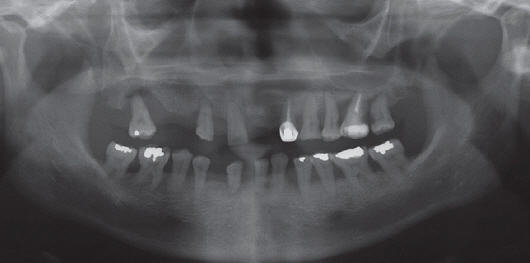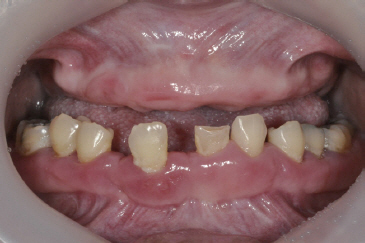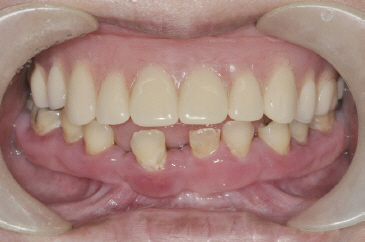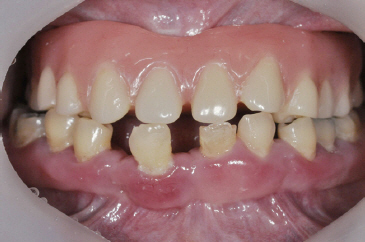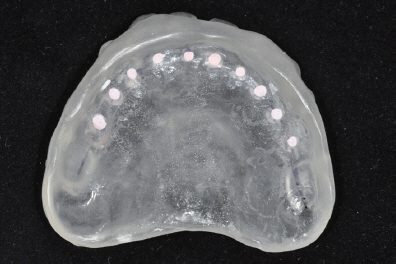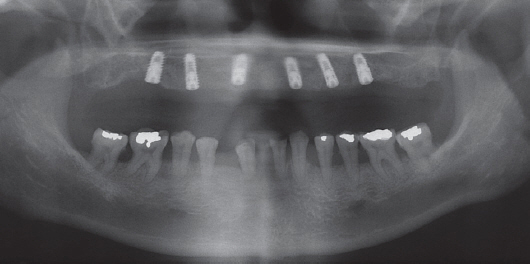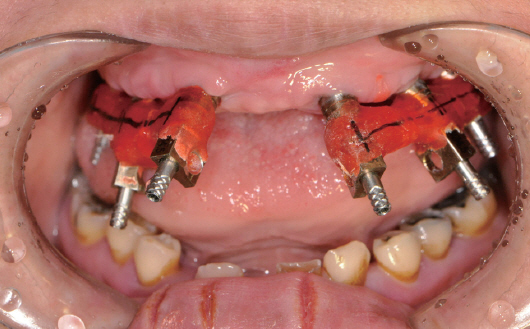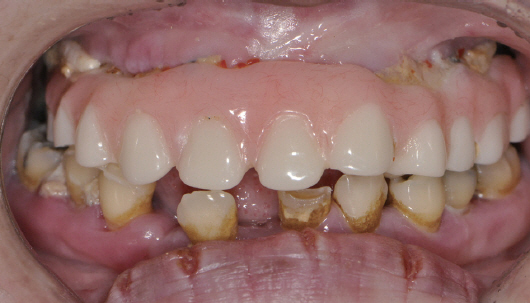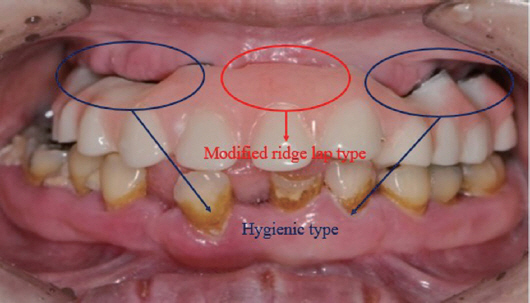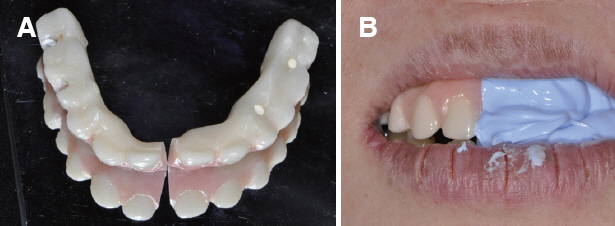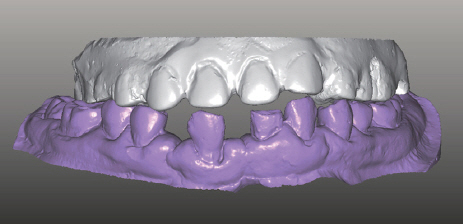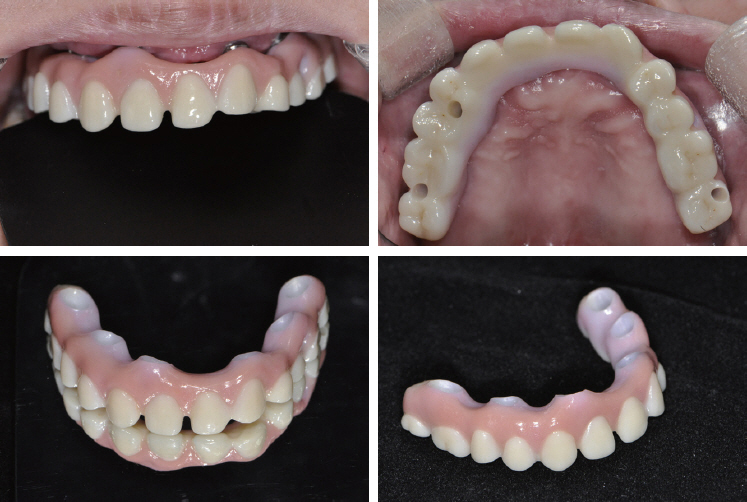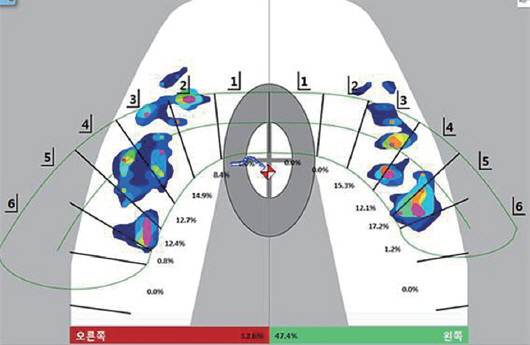J Dent Rehabil Appl Sci.
2018 Sep;34(3):225-231. 10.14368/jdras.2018.34.3.225.
Implant hybrid prosthetic treatment in Down syndrome patient: a case report
- Affiliations
-
- 1Department of Prosthodontics, School of Dentistry, Chosun University, Gwangju, Republic of Korea. lkj1998@chosun.ac.kr
- KMID: 2422641
- DOI: http://doi.org/10.14368/jdras.2018.34.3.225
Abstract
- Down syndrome patients generally have poor oral hygiene due to lack of awareness and ability to perform oral care, and there is a high risk of tooth loss. Also, they are characterized by small and irregular teeth and oligodontia, which makes it difficult to do prosthetic treatment. This article reports a case of implant hybrid prosthesis treatment of maxillary edentulous area in Down syndrome patient. The external shape of the final prosthesis was determined by using the mandibular artificial teeth to reflect the oligodontia of the mandible and the pontic areas were adjusted to facilitate oral hygiene care. As a result, aesthetically and functionally satisfactory results were obtained.
MeSH Terms
Figure
Reference
-
References
1. Faulks D, Collado V, Mazille MN, Veyrune JL, Hennequin M. Masticatory dysfunction in persons with Down's syndrome. Part 1:aetiology and incidence. J Oral Rehabil. 2008; 35:854–62. DOI: 10.1111/j.1365-2842.2008.01877.x. PMID: 18702629.2. Cheng RHW, Yiu CKY, Leung WK. Oral health in individuals with down syndrome. Dey S, editor. Prenatal diagnosis and screening for down syndrome. 2011. London: IntechOpen;p. 59–76.3. Oliveira AC, Paiva SM, Campos MR, Czeresnia D. Factors associated with malocclusions in children and adolescents with Down syndrome. Am J Orthod Dentofacial Orthop. 2008; 133:489.e1–8. DOI: 10.1016/j.ajodo.2007.09.014. PMID: 18405808.4. Desai SS, Flanagan TJ. Orthodontic considerations in individuals with Down syndrome:a case report. Angle Orthod. 1999; 69:85–8. PMID: 10022190.5. Rich BM, Augenbraun H. Treatment planning for the edentulous patient. J Prosthet Dent. 1991; 66:804–6. DOI: 10.1016/0022-3913(91)90421-R. PMID: 1805035.6. DeBoer J. Edentulous implants;overdenture versus fixed. J Prosthet Dent. 1993; 69:386–90. DOI: 10.1016/0022-3913(93)90186-R. PMID: 8463968.7. Misch CE. Dental Implant Prosthetics. 2015. 2nd ed. St. Louis: Elsevier;p. 189–94.8. Tjan AH. A sanitary “arc-fixed partial denture”:concept and technique of pontic design. J Prosthet Dent. 1983; 50:338–41. DOI: 10.1016/S0022-3913(83)80087-0. PMID: 6352920.9. Becker CM, Kaldahl WB. Current theories of crown contour, margin placement, and pontic design. 1981. J Prosthet Dent. 2005; 93:107–15. DOI: 10.1016/j.prosdent.2004.11.005. PMID: 15674218.10. Altarawneh S, Limmer B, Reside GJ, Cooper L. Dual jaw treatment of edentulism using implantsupported monolithic zirconia fixed prostheses. J Esthet Restor Dent. 2015; 27:63–70. DOI: 10.1111/jerd.12137. PMID: 25640984.
- Full Text Links
- Actions
-
Cited
- CITED
-
- Close
- Share
- Similar articles
-
- Decoronation and implant restoration of ankylosed tooth resulted from anterior avulsion: A case report
- Usage of digital technique to facilitate communication between dentist, dental lab technician, and patients in diagnosis and restoration for maxillary anterior implant: a case report
- Retreatment of implant-supported hybrid prosthesis with existing metal framework: a case report
- Prognostic factors influencing implant survival and marginal bone loss in patients with osteoporosis or osteopenia medication
- Full mouth rehabilitation of fully edentulous patient with implant-supported fixed prosthesis preceding bone graft: A case report

